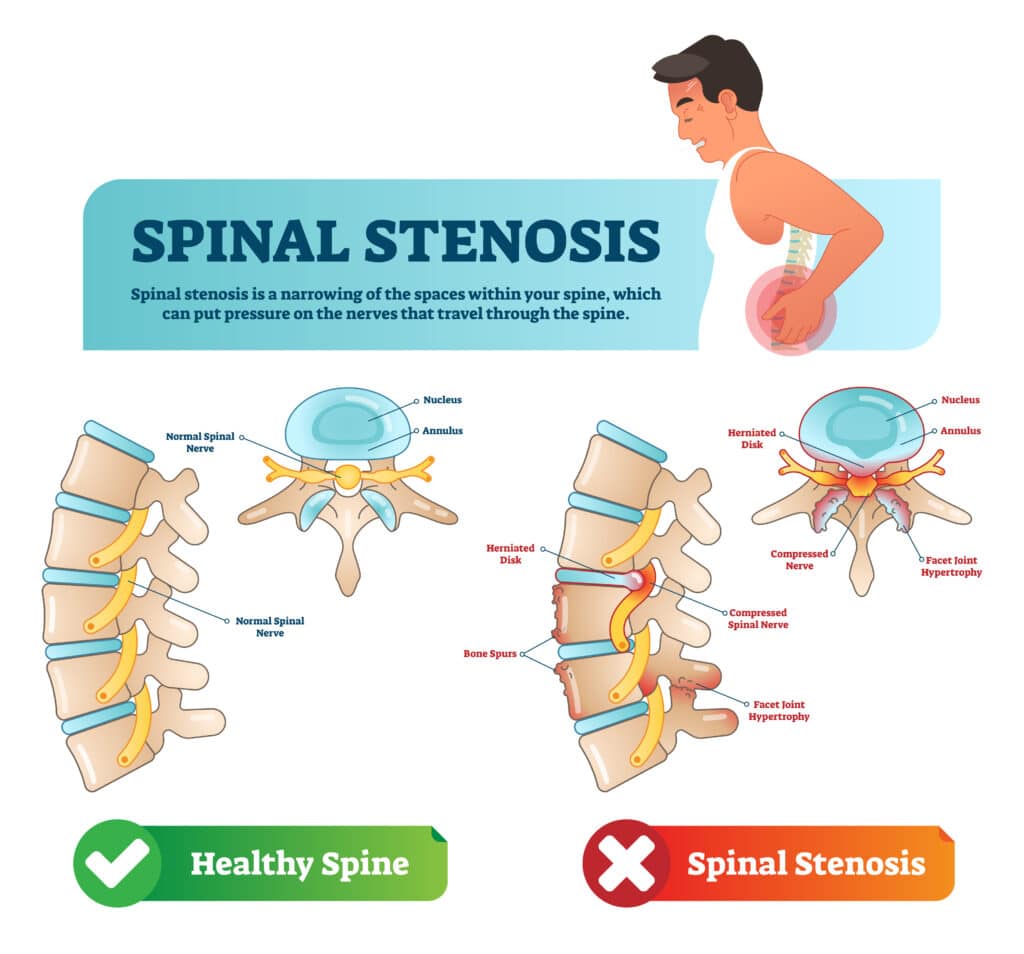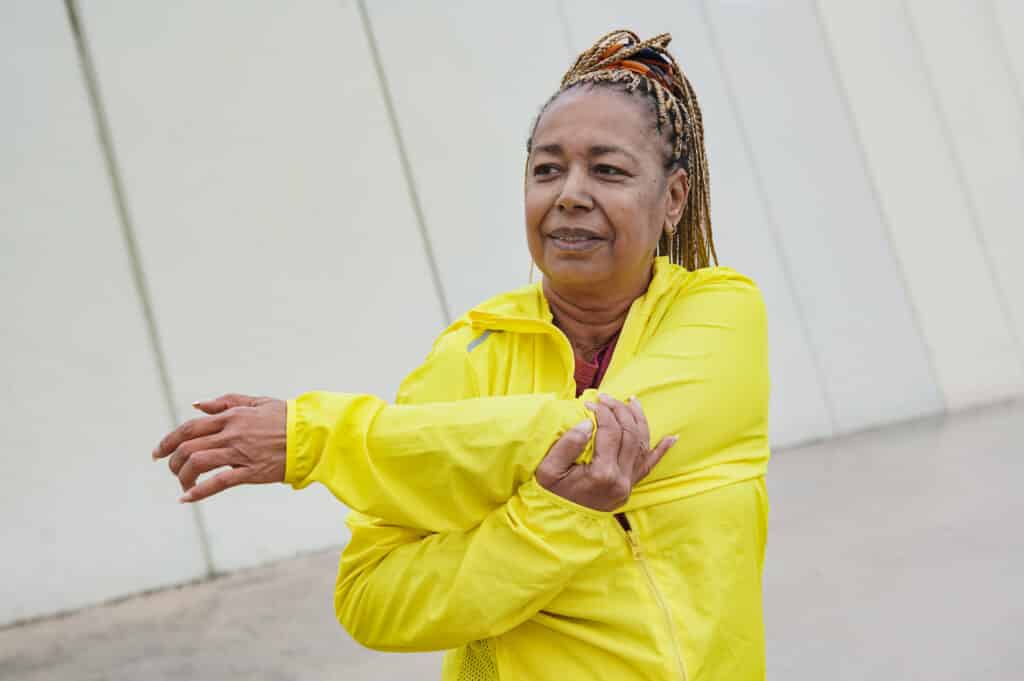If your doctor has recommended exercises for spinal stenosis, you’re on the path to regaining mobility and reducing discomfort. Spinal stenosis can make daily activities challenging, but with the right exercises, significant relief is within reach.
This article will introduce you to effective exercises for spinal stenosis, such as the Counter Stretch and Child’s Pose for flexibility and the Bridge with Tuck and Dead Bug for strength. These exercises are designed to ease tight muscles, create more space for your nerves, and build crucial muscle support around your spine.
By incorporating these movements into your routine, you can enhance your flexibility, strengthen your back, and enjoy a more active, pain-free life.
Let’s explore how these exercises can help you manage spinal stenosis symptoms and improve your overall well-being.
The Basics of Spinal Stenosis

Spinal stenosis occurs when the space around the nerves in your back—known as the spinal canal—becomes narrowed.1
Think of a busy highway that’s narrowed to one lane over time, causing traffic jams and sometimes complete stops.
The spinal canal is like a highway for your nerves, and when it becomes constricted, the nerves inside the canal receive too much pressure, creating a ‘bottleneck’ effect. This can result in pain, weakness, or numbness, usually in the legs.
Spinal stenosis is common in older adults because it’s usually caused by changes in the spine related to osteoarthritis and joint wear.
My patients often describe the feeling as a tightening of their back or legs that can be painful and make it difficult to move around.
Let’s look at how spinal stenosis exercises might be useful to find relief.
The Importance of Regular Exercise

Engaging in regular exercise is beneficial and essential for managing the symptoms of spinal stenosis. It acts as preventative maintenance for your body, akin to servicing a vehicle to ensure it runs smoothly and efficiently.
Exercise offers immediate relief by enhancing flexibility and strength, reducing the undue pressure on the nerves within your spinal canal.
Like any part of your body, your spine adapts and strengthens with regular exercise, gradually mitigating the discomfort of stenosis.
While the initial relief is promising, the true transformation in your spinal health lies in long-term consistency.
Reducing Pain Through Movement
One of the most significant benefits my patients report from regular exercise is a noticeable reduction in pain. This is a direct result of improved muscle strength and flexibility around the spine.
Exercises specifically designed to target the muscles that directly or indirectly support your spinal canal.
By limiting the pressure on the nerves, these exercises help minimize the chronic pain often associated with spinal stenosis. The result is a non-pharmaceutical method of managing pain effectively.
Enhancing Mobility for a Fuller Life
Improved mobility is a game-changer for individuals suffering from spinal stenosis. Stretching and strengthening exercises can achieve a greater range of motion, making everyday movements easier and less painful.
This isn’t just about physical health; it’s about reclaiming your independence and the ability to engage in activities that bring joy and fulfillment to your life.
Mobility exercises aim to enhance physical capacity and promote a more active and engaging lifestyle.
Strengthening Spinal Stability for Long-Term Health
A strong back and core are your spine’s best allies. Regular exercise builds up these critical muscles, offering improved support and stability for your spine.
This bolstered support is crucial in preventing further constriction of the spinal canal. Beyond immediate symptom relief, this increased muscle strength plays a vital role in safeguarding your spine against the progression of stenosis to improve your long-term spinal health.
Slowing Disease Progression Through Active Engagement
Consistent physical activity can slow down the disease’s advancement by reducing stress and wear on your spinal canal.
This proactive approach improves your current quality of life and may allow you to avoid more invasive treatments in the future.
Committing to regular exercise could be the key to maintaining a healthy spine and staying ahead of stenosis.
Boosting Mental Health Alongside Physical Well-being
Regular exercise is a reliable ally in maintaining physical and mental health.
The impact of chronic conditions like spinal stenosis extends beyond physical discomfort, often taking a toll on mental health.
The benefits of regular exercise go beyond physical improvement, playing a critical role in mental and emotional well-being. The reduction in pain and increased mobility contribute to a more positive outlook on life, combating the psychological strain of living with a chronic condition.
In short, exercise provides a safe and holistic approach to managing spinal stenosis. Let’s look at some of the most effective spinal stenosis exercises I use with my patients.
My Favorite Spinal Stenosis Exercises
As we learned in the previous section, tailored exercises aren’t just about treating a condition; they’re about empowering you to lead a healthier, more active life despite the challenges of spinal stenosis.
Exercise can help adults with spinal stenosis in different ways, so organizing spinal stenosis exercises by their type and the benefits they provide is helpful.
Here, we will focus on flexibility, strength, and aerobic exercise.
Spinal Stenosis Exercises for Flexibility
Flexibility exercises are an important component of an exercise routine for those with spinal stenosis.
Stretching helps relieve tight muscles and creates more space for the nerves in your back. Here are two examples to try:
Counter Stretch
- Start by standing in front of a counter or another stable surface with your feet shoulder-width apart. In this case, Dr. Kathy is using a sturdy wooden chair.
- Holding onto the counter, slowly bend forward at your waist and allow your weight to shift backward without losing balance. You should feel a gentle stretch in your lower back.
- Hold this stretch for 30-60 seconds, then return to the starting position.
Child’s Pose
- Start on all fours with your hands beneath your shoulders and your knees beneath your hips.
- Slowly rock back toward your heels and walk your hands forward until you feel a stretch in your lower back.
- Hold this stretch for 30-60 seconds, then return to the starting position.
With either of these exercises, you can move your hands to the opposite side of your symptoms to increase the stretch on the affected area, often providing more relief than reaching straight forward.
This is one of the number one stretching tips I provide to my patients with spinal stenosis.
Exercises for Building Strength
Keeping your spine strong and stable is essential to reduce the pain and mobility problems from spinal stenosis. Building strength in weak areas can help remove pressure from your stenotic area, relieving symptoms.
Here are two examples to try:
Bridge with Tuck
- Start by lying on your back with your knees bent and your feet between hip and shoulder-width apart.
- Tuck your tailbone underneath you, then raise your hips by squeezing your glute muscles.
- Pause after making a straight line between your hips and shoulders, then return to the start.
Dead Bug
- Start by lying on your back with your knees bent, thighs pointing straight up, and arms pointing straight up.
- Slowly lower each limb to the floor, one at a time, reaching your arms over your head and your legs straight down.
- Hold the extended limb in the end position briefly, then return to the start.
- Do five repetitions with each limb, then rest.
Advanced Version:
- Keeping your back flat against the floor, slowly lower one foot and your opposite arm toward the floor. Lowering two limbs at once is slightly more challenging.
- Tap the floor with your foot and hand, then return to the start and repeat with your opposite side.
- Hold the extended limbs in the end position briefly, then return to the start.
- Do ten repetitions with each limb pair, then rest.
Tip: The key to both exercises is to keep the pelvis tucked by tightening your abs and not allowing the back to arch. If your core is weak or your form is off, the back will begin to arch and may result in pain. When done correctly, you should not feel these exercises in your back but in your abs and legs.
Aerobic Exercise for Overall Health and Wellness
Although it doesn’t directly impact spinal stenosis in the same way that flexibility and strength training do, aerobic exercise is important for a healthy lifestyle.
It provides a great way to encourage spine movement, promote circulation and lubrication, and manage pain through natural endorphin release.3
Activities like walking, cycling, and water aerobics are all great ways to raise your heart rate without putting undue stress on your spine.
Regular aerobic exercise also improves endurance and makes it easier to maintain a healthy weight for a healthier spine.
I recommend walking to most of my older adult patients because it helps get your back moving, is a relatively low-stress exercise, and often means spending time outside, which is great for stress management and emotional health.
What If Walking Doesn’t Feel Good?
If walking seems too challenging for you, I recommend utilizing assistive devices.
For example, I commonly recommend that patients use an assistive device such as a rollator. This device allows patients to lean forward and take pressure off the back or seat as needed, allowing them to walk further without high pain levels.
Getting the Most Out of Your Exercise Routine

A new exercise program can be intimidating, especially if you’re living with the symptoms of spinal stenosis.
I always remind my patients that the key is to gently and slowly increase the intensity as their bodies get used to the movement.
You don’t have to push through pain—that’s the opposite of what we want. Listen to what your body tells you, and focus on safely performing spinal stenosis exercises.
Find A Routine That Works for You
It’s important to remember that while the symptoms and causes of spinal stenosis are similar among individuals, each case needs to be treated with an exercise plan tailored to the individual’s unique needs and goals.
This means considering your specific range of motion and picking the areas where you need the most strength and flexibility training. This is essential to building a successful exercise routine for long-term success.
Exercising Safely
Exercise is only as good as your technique and safety, so always listen to your body and stop if something feels wrong.
This means using proper form, avoiding painful movements or stressing an injured area, and being aware of your limitations.
This is especially important when exercising with spinal stenosis. If you can’t perform an exercise correctly, modify it or ask a professional for help.
Your goal is to recover and start feeling better, not to injure yourself further. If you’re feeling pain or new symptoms, I recommend talking with your physical therapist.
Key Takeaways
- Spinal stenosis narrows the spinal canal, causing pain, weakness, or numbness, typically in the legs.
- Regular exercise can significantly reduce spinal stenosis symptoms by enhancing flexibility and strength around the spine.
- Exercises such as the Counter Stretch and Child’s Pose help to relieve tight muscles and create more space for nerves.
- Strength-building exercises like the Bridge with Tuck and Dead Bug provide essential support for the spine, reducing nerve pressure.
- Aerobic exercises like walking, cycling, and water aerobics promote overall health and help manage spinal stenosis symptoms.
- Consistent exercise can slow disease progression, improve spinal stability, and reduce the need for more invasive treatments.
- Regular physical activity boosts mental health by reducing pain, enhancing mobility, and improving the overall quality of life.
- Consulting a physical therapist can help tailor an exercise plan to your specific needs and ensure exercises are performed safely.
- Utilizing assistive devices, such as a rollator, can help those who find walking challenging due to spinal stenosis.
- Listening to your body and avoiding pain during exercise is crucial for managing spinal stenosis effectively.
FAQs
References
- Raja A, Hoang S, Patel P, et al. Spinal Stenosis. [Updated 2023 Jun 12]. In: StatPearls [Internet]. Treasure Island (FL): StatPearls Publishing; 2024 Jan-. Available from: https://www.ncbi.nlm.nih.gov/books/NBK441989/
- Mo Z, Zhang R, Chang M, Tang S. Exercise therapy versus surgery for lumbar spinal stenosis: A systematic review and meta-analysis. Pak J Med Sci. 2018 Jul-Aug;34(4):879-885. doi: 10.12669/pjms.344.14349. PMID: 30190746; PMCID: PMC6115590.
- Gordon R, Bloxham S. A Systematic Review of the Effects of Exercise and Physical Activity on Non-Specific Chronic Low Back Pain. Healthcare (Basel). 2016 Apr 25;4(2):22. doi: 10.3390/healthcare4020022. PMID: 27417610; PMCID: PMC4934575.
- Basso JC, Suzuki WA. The Effects of Acute Exercise on Mood, Cognition, Neurophysiology, and Neurochemical Pathways: A Review. Brain Plast. 2017 Mar 28;2(2):127-152. doi: 10.3233/BPL-160040. PMID: 29765853; PMCID: PMC5928534.




